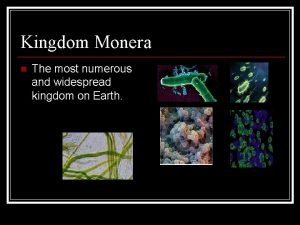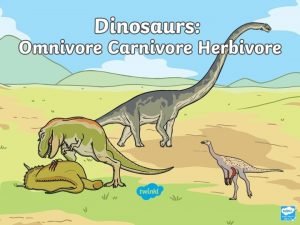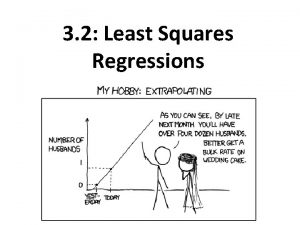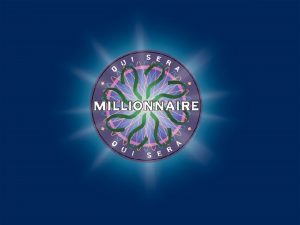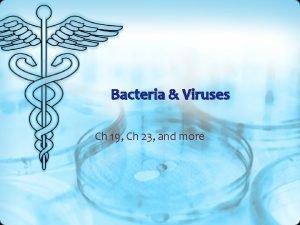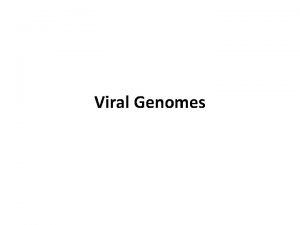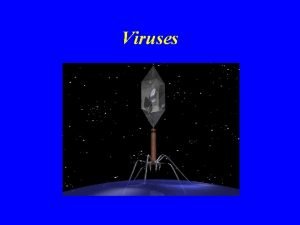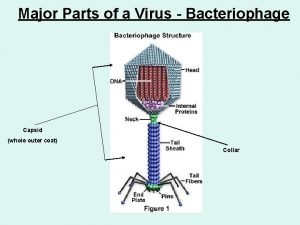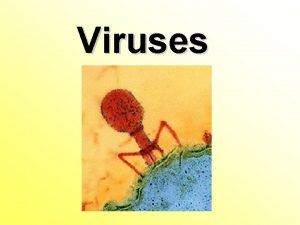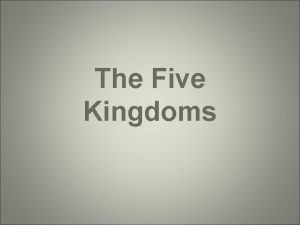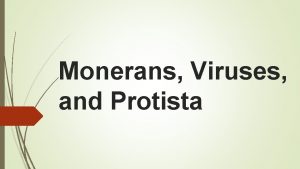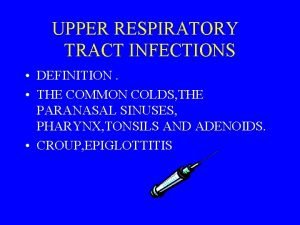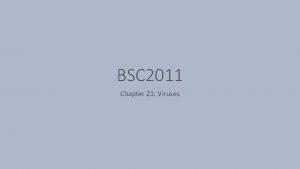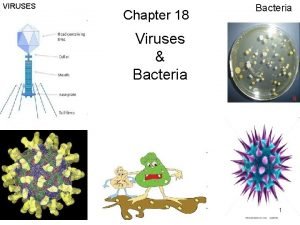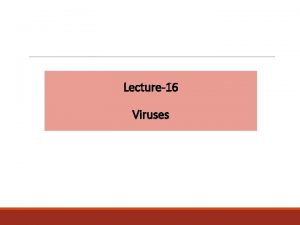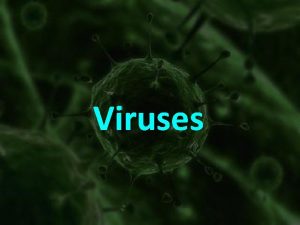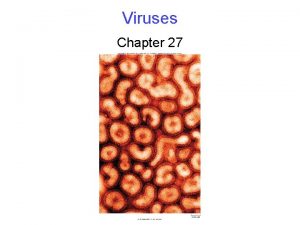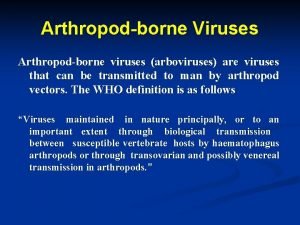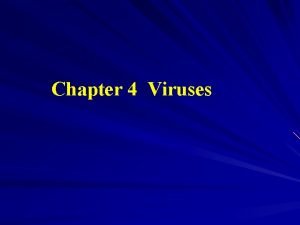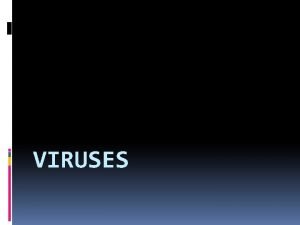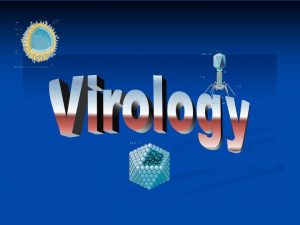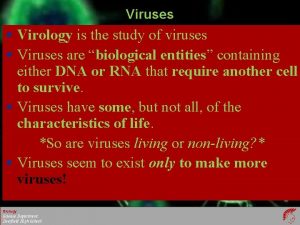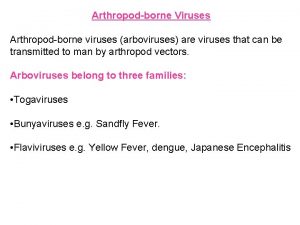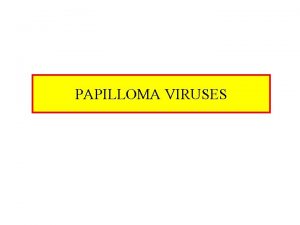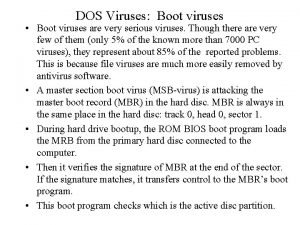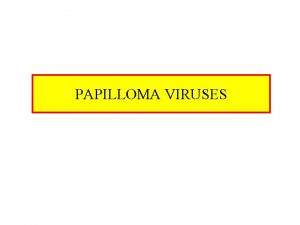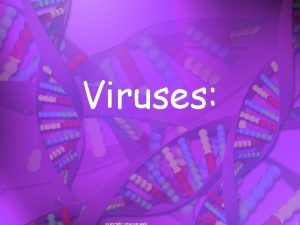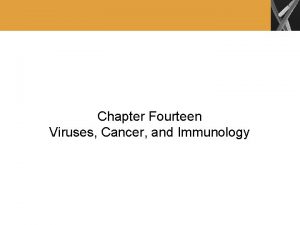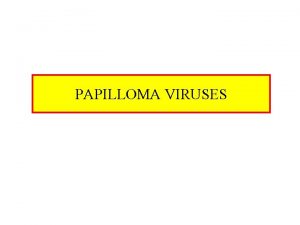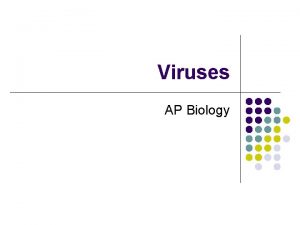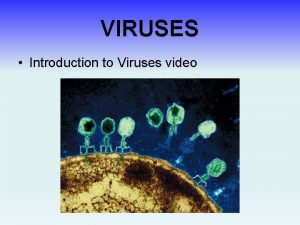Viruses Monerans Millions of people get colds infections












































- Slides: 44

Viruses & Monerans Millions of people get colds & infections (infxns) caused by microorganisms (m/o) such as viruses & bacteria. Viruses are smaller than the smallest known cell – even bacteria (bac). Viruses cause many diseases other than colds such as…? Bac. also cause diseases such as strep throat, pneumonia, ear infxns, etc. Bac belong to the kingdom Monera.

I. Viruses: • if people were the sizes of viruses, everyone in the U. S. would fit on the end of 2 pencil erasers w/room left over. • *** Viruses are NOT!! living things. Viruses are like a bridge between living & non living things. • Where & how viruses originated is not known; they may have been genes that lived off other living things.

A. Nature of viruses: • Viruses are complex submicroscopic organic particles; they do not carry out any life fxns on their own • Viruses can be frozen & stored for years & reactivated when placed inside a living cell. • Viruses are NOT cells; they replicate (NOT reproduce), but ONLY when they are in a living cell. • Viruses are absolute parasites, i. e. , they “live” off another organism w/no benefit to that organism.

• They are found in air, H 2 O, & soil & can enter the body through skin, food, drink, & inhalation. • A virus is made up of a nucleic acid (na) core & a protein coat called a capsid. • ALL living things contain both DNA & RNA; viruses are made up of either DNA or RNA but NOT both. • In addition to a capsid, some viruses have an outer covering called an envelope, which is also made up of proteins. All of these proteins help a virus attach itself to the cell’s surface of a host.

II. Classification of Viruses A. Shape: viruses have 4 basic shapes. 1. Rod shaped eg. Tobacco mosaic virus

2. Spherical eg HIV 3. Polyhedral (many sides) eg. Adenovirus

4. Polyhedral w/tail eg. Bacteriophage (attacks bacteria)

B. Nucleic Acid: • viruses are classified by their nucleic acid: DNA or RNA 1. DNA viruses Eg • Herpes virus… cold sores, genital herpes, chicken pox, mono • Poxvirus………smallpox • Papovirus……. warts in people, dogs, & rabbits

2. RNA viruses • Enteroviruses…………. . diarrhea, polio • Rhino viruses…………………. . …cold • Rhabdo virus…………. . . rabies • Retro viruses…………. . . leukemia, HIV C. Vectors: are ANYTHING that can carry or transmit a disease causing m/o.

Viruses that infect animals are carried by vectors such as: • needles • body fluids • H 2 O, food • Insects Animal viruses can also be spread by: • coughing • sneezing • phys’l contact

D. Host: • is any organism that the virus will infect. VERY specific to organism & even cell w/in an organism. • Eg: HIV primates only WBC/T 4 of primates E. Envelope: see above

III. Viral replication: • nucleic acids & proteins are needed for viruses to replicate themselves – they cannot make any of these on their own - they have to make host cells make them. Viruses are either: A. Lytic: destroy the host cell during replication immediately. OR B. Lysogenic: virus does NOT kill host cell during replication right away.

Lytic Cycle: See handout on cycles, answer questions

1. Attachment: virus attaches to a cell @ a specific receptor site. 2. Entry: nucleic acid enters into the cell. 3. Replication: viral gene tells the host cell to make new viral nucleic acid & proteins using nrg & materials of the host cell. 4. Assembly: new virus particles are assembled in the cell. 5. Lysis: the new viruses now tell the cell to make enzymes to break down or lyse the host cell; Host cell dies! 100’s or > new viruses are released; each can now go & infect another cell & begin the cycle again.

Lysogenic Cycle: see handout on cycle, answer questions

1. Attachment & entry: lysogenic virus injxts into host cell. 3. Prophage or provirus stage: viral nucleic acid becomes part of host cell’s chromosome. 4. Cell division: prophage is not yet active but divides w/the cell. 5. Lytic phase: something triggers the viral nucleic acid to start the lytic phase: replication, assembly, & lysis.

• Some viruses remain like this in the host cells for years w/o causing a disease – eg herpes & HIV. • The virus continues to replicate & those that have the virus can spread it to others. • Once the nucleic acid becomes activated, the lytic cycle begins.

IV. Viruses & Diseases: • we encounter numerous viruses everyday; our body is able to fight off most, & many viruses don’t cause diseases in humans. • Many viruses are destroyed by the body’s white blood cell (WBC). • If not by WBC, then by specific chemicals called antibodies (ab) the body makes that attach to & attack the virus. • They either destroy it or hold them ‘till the wbc’s come & destroy them.

• If a virus does infect an animal cell, interferon, a protein, is produced in animal cells infected by viruses. It inhibits viral replication in uninfxd cells. • Viral diseases are difficult to treat b/c they invade our cells & can remain hidden for years w/o causing any illness or symptoms. • Also, drugs that kill bacteria do NOT destroy viruses.

• Some viral disease is prevented by vaccines: prepared from viral parts, “dead”, inactivated, or altered viruses. • The body then responds like a real infxn producing WBC’s & ab. • The body is then immune to that virus. Eg of some vaccines: rabies, smallpox, polio. ******

Kingdom Monera: bacteria • Several types of bac make up the kingdom Monera. • Bac are prokaryotes: simple one celled m/o. Bacterium Transparency

I. Characteristics: • See hand out; do questions. • Monerans are unicellular microorganisms. Bacterium (sg) from the Greek for small rod. Monerans are NOT animal cells; the have NO membrane organelles such as: - mitochondria - NUCLEUS - endoplasmic reticulum - lysosomes

• They do have ribosomes to make proteins & a large circular DNA structure called a plasmid. • They have a cell wall that’s rigid & strong & resists changes & the axn of many drugs. • Some bac have a capsule located outside the cell wall as an external protective layer. It protects them from being easily digested by body fluids.

A. Nutrition: • most bac are heterotrophs. Others are autotrophs of 2 primary types: 1. photoautotrophs: produce nutrients by photosynthesis (light nrg to nutrients). 2. chemoautotrophs: produce nutrients by chemosynthesis (Chem’l nrg to nutrients)

II. Life of Bacteria: • bac are found in EVERY possible habitat – from the frozen Arctic to the hot springs of Yellowstone park. • Bac reproduce rapidly. Some can use substances that are toxic to other organisms. • Eg some bac use DDT (a pesticide) as a nutrient source.

• Bac can exist under extreme conditions. Eg – everyday bac (which we need) survive in our digestive system helping us breakdown food. • This is mutualism: a relationship between 2 species w/both benefiting. • All these factors are part of the success of bac.

A. Reprodxn: bac reproduce by: 1. Binary Fission: asexual (w/o sex) reprodxn. • DNA is doubled & divided =ly between the 2 new cells • 2 new daughter cells pinch inward & pull apart (fission) making 2 separate cells.


2. Conjugation: • DNA is exchanged between bac thru a pilus.

C. Bac that MUST have O 2 to live are called obligate aerobes. Eg bac that causes tuberculosis. • Bac that must live w/o O 2 are called obligate anaerobes. Eg C. botulinum that causes botulism. • Some produce endospores: a thick walled structure inside the cell that protects the plasmid & some cytoplasm during extreme conditions. • Some bac form a colony: 2 or more similar bac forming groups in clusters or chains.

clusters chains

III. Classification: • bac are differentiated into major categories based upon the following. • Cell size: most are smaller than eukaryotes. Eg of comparative sizes: RBC E. coli Pox virus Parvovirus 8 um 2 um 250 nm 28 nm

B. Colony Type: color, rough, smooth, shiny, dull. C. Bac’l Shapes: 3 basic shapes. 1. Bacillus: rod shaped. Eg E. coli

2. Coccus: round eg Streptococcus 3. Spirillum: spiral or curved. Eg Leptospirosa

IV. Cyanobacterium: • blue-green algae b/c they contain chlorophyll a. • They are therefore autotrophs: make their own food. Their color may actually vary to brown – red. Blue –green Brown Red

• Cynaobac. are found in ponds, lakes, pools, & sometimes-leaky faucets; also in salt H 2 O & snow. • Sometimes, cyanobac choke these H 2 O areas; the growth is called a bloom; the algae die in great #’s, decay, & deplete the O 2 supply, which kills other life in ponds, like fish. Blooms

V. Bac & Diseases: • both plants & animals can be infxd by bac & come down w/diseases. • Some human diseases eg: TB, pneumonia, syphilis, & strep. • Bac that cause diseases are pathogens. A. Zoological: diseases that can be passed from animal to humans such as: rabies, flu, anthrax, HIV.

B. Communicable diseases: • • are spread in many ways: between organisms - insects air - dirt sneeze or cough - touch objects - sex food - other H 2 O

VI. How Bac Live A. Parasites: like viruses, some bac are parasites, hurting the host they live off. B. Saprophytes: a saprobe is a m/o that lives off of dead organic organisms • they are decomposers, breaking down dead, organic matter & live off it. Saprobes play a vital role in recycling material – N, C, etc. , in nature.

C. Mutualism: • a relationship between 2 species w/both benefiting. E. coli in our G-I tract. They break down & use our food we can’t digest, giving us more nutrients & produce some vitamins. • The microbes that normally live in associations with humans on the various surfaces of the body (called the normal flora), such as Lactobacillus and Bifidobacterium, are known to protect their hosts from infections, and otherwise promote nutrition and health.

VII. Helpful Bac: • most bac are helpful & necessary to life; they: A. Decompose dead matter (see above) B. Breakdown material other organisms may use (see above) C. Biotechnology: bac aid in solving problems & in industry. Eg: oil “eating” bac, insulin prodxn, produce natural gas, others. D. Used to make products such as: • linen & rope - coffee & cocoa flavoring • leather - sauerkraut • antibiotics - vinegar • cheese & dairy


VIII. Controlling bac • is necessary in some cases to prevent spoiling of food, infxns, disease, etc. Ways to do so: • Heat sealed cans: prevents C. botulinum , staph, others from food poisoning. • Boiling food/proper cooking: to prevent the same above. • Pasteurization: heating milk, liquids to kill off bac. • Cooling/freezing: slows/stops bac’l growth. • Dehydration: w/draw H 2 O from food, other products; H 2 O is necessary for bac to live.

• Antiseptics: chem’ls that kill bac on living things. Eg: iodine. • Disinfectants: kills bac on NON living things. Eg bleach. • Hygiene: H 2 O, soap, toothpaste. • Antibiotics, medicine, vaccines aid in preventing or ridding a bac’l infxn or disease. End for Exam
 Get on get off
Get on get off Watch?v=dckvspcd8gs
Watch?v=dckvspcd8gs Unlike lytic viruses lysogenic viruses do not
Unlike lytic viruses lysogenic viruses do not What are monerans
What are monerans One direction shot me out of the sky
One direction shot me out of the sky Bone and joint infections
Bone and joint infections Opportunistic infections
Opportunistic infections Genital infections
Genital infections Johnson and johnson botnet infections
Johnson and johnson botnet infections Neurosiphyllis
Neurosiphyllis Methotrexate yeast infection
Methotrexate yeast infection Amber blumling
Amber blumling Storch infections
Storch infections Postpartum infections
Postpartum infections Eye infections
Eye infections Opportunistic infections
Opportunistic infections Nosocomial infections
Nosocomial infections Storch infections
Storch infections Retroviruses and opportunistic infections
Retroviruses and opportunistic infections A bacterial std that usually affects mucous membranes
A bacterial std that usually affects mucous membranes Acute gingival infections
Acute gingival infections Herbivores dinosaur
Herbivores dinosaur The scatterplot shows the payroll (in millions of dollars)
The scatterplot shows the payroll (in millions of dollars) Mechanical isolation
Mechanical isolation Financial statement in millions
Financial statement in millions There are millions of stars in
There are millions of stars in Europe population in millions
Europe population in millions Qui veut gagner des bonbons
Qui veut gagner des bonbons Qui veut gagner des millions 50/50
Qui veut gagner des millions 50/50 Paid drawing. it be work millions.
Paid drawing. it be work millions. Millions billions trillions chart
Millions billions trillions chart Drawing. could be work millions.
Drawing. could be work millions. What is the jackpot on mega millions
What is the jackpot on mega millions Get up get moving quiz
Get up get moving quiz Germer
Germer Get up get moving
Get up get moving Example of sequence in pseudocode
Example of sequence in pseudocode Get up get moving quiz
Get up get moving quiz Get focused get results
Get focused get results Are viruses alive yes or no
Are viruses alive yes or no General characteristics of viruses
General characteristics of viruses What is the smallest infectious agent
What is the smallest infectious agent General properties of viruses
General properties of viruses Parts of the viruses
Parts of the viruses Importance of viruses
Importance of viruses



